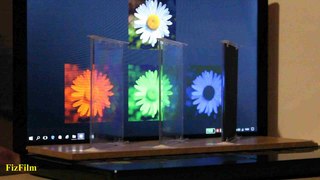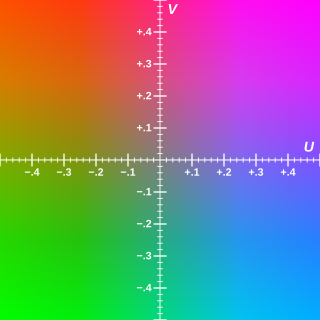Related Research Articles

JPEG is a commonly used method of lossy compression for digital images, particularly for those images produced by digital photography. The degree of compression can be adjusted, allowing a selectable tradeoff between storage size and image quality. JPEG typically achieves 10:1 compression with little perceptible loss in image quality. Since its introduction in 1992, JPEG has been the most widely used image compression standard in the world, and the most widely used digital image format, with several billion JPEG images produced every day as of 2015.

Portable Network Graphics is a raster-graphics file format that supports lossless data compression. PNG was developed as an improved, non-patented replacement for Graphics Interchange Format (GIF)—unofficially, the initials PNG stood for the recursive acronym "PNG's not GIF".
PCX, standing for PiCture eXchange, was an image file format developed by the now-defunct ZSoft Corporation of Marietta, Georgia, United States. It was the native file format for PC Paintbrush and became one of the first widely accepted DOS imaging standards, although it has since been succeeded by more sophisticated image formats, such as BMP, JPEG, and PNG. PCX files commonly stored palette-indexed images ranging from 2 or 4 colors to 16 and 256 colors, although the format has been extended to record true-color (24-bit) images as well.

The RGB color model is an additive color model in which the red, green and blue primary colors of light are added together in various ways to reproduce a broad array of colors. The name of the model comes from the initials of the three additive primary colors, red, green, and blue.

YUV is a color model typically used as part of a color image pipeline. It encodes a color image or video taking human perception into account, allowing reduced bandwidth for chrominance components, compared to a "direct" RGB-representation. Historically, the terms YUV and Y′UV were used for a specific analog encoding of color information in television systems. Today, the term YUV is commonly used in the computer industry to describe colorspaces that are encoded using YCbCr.

In photography and videography, multi-exposure HDR capture is a technique that creates extended or high dynamic range (HDR) images by taking and combining multiple exposures of the same subject matter at different exposure levels. Combining multiple images in this way results in an image with a greater dynamic range than what would be possible by taking one single image. The technique can also be used to capture video by taking and combining multiple exposures for each frame of the video. The term "HDR" is used frequently to refer to the process of creating HDR images from multiple exposures. Many smartphones have an automated HDR feature that relies on computational imaging techniques to capture and combine multiple exposures.
The BMP file format or bitmap, is a raster graphics image file format used to store bitmap digital images, independently of the display device, especially on Microsoft Windows and OS/2 operating systems.
Color depth or colour depth, also known as bit depth, is either the number of bits used to indicate the color of a single pixel, or the number of bits used for each color component of a single pixel. When referring to a pixel, the concept can be defined as bits per pixel (bpp). When referring to a color component, the concept can be defined as bits per component, bits per channel, bits per color, and also bits per pixel component, bits per color channel or bits per sample (bps). Modern standards tend to use bits per component, but historical lower-depth systems used bits per pixel more often.
Netpbm is an open-source package of graphics programs and a programming library. It is used mainly in the Unix world, where one can find it included in all major open-source operating system distributions, but also works on Microsoft Windows, macOS, and other operating systems.

High-dynamic-range rendering, also known as high-dynamic-range lighting, is the rendering of computer graphics scenes by using lighting calculations done in high dynamic range (HDR). This allows preservation of details that may be lost due to limiting contrast ratios. Video games and computer-generated movies and special effects benefit from this as it creates more realistic scenes than with more simplistic lighting models.
An image file format is a file format for a digital image. There are many formats that can be used, such as JPEG, PNG, and GIF. Most formats up until 2022 were for storing 2D images, not 3D ones. The data stored in an image file format may be compressed or uncompressed. If the data is compressed, it may be done so using lossy compression or lossless compression. For graphic design applications, vector formats are often used. Some image file formats support transparency.
A camera raw image file contains unprocessed or minimally processed data from the image sensor of either a digital camera, a motion picture film scanner, or other image scanner. Raw files are so named because they are not yet processed, and contain large amounts of potentially redundant data. Normally, the image is processed by a raw converter, in a wide-gamut internal color space where precise adjustments can be made before conversion to a viewable file format such as JPEG or PNG for storage, printing, or further manipulation. There are dozens of raw formats in use by different manufacturers of digital image capture equipment.
In computing, indexed color is a technique to manage digital images' colors in a limited fashion, in order to save computer memory and file storage, while speeding up display refresh and file transfers. It is a form of vector quantization compression.
Radiance is a suite of tools for performing lighting simulation originally written by Greg Ward. It includes a renderer as well as many other tools for measuring the simulated light levels. It uses ray tracing to perform all lighting calculations, accelerated by the use of an octree data structure. It pioneered the concept of high-dynamic-range imaging, where light levels are (theoretically) open-ended values instead of a decimal proportion of a maximum or integer fraction of a maximum. It also implements global illumination using the Monte Carlo method to sample light falling on a point.
Logluv TIFF is an encoding used for storing high-dynamic-range imaging data inside a TIFF image. It was originally developed by Greg Ward for storing HDR-output of his Radiance-photonmapper at a time where storage space was a crucial factor. Its implementation in TIFF also allowed the combination with image-compression algorithms without great programming effort. As such it has to be considered a smart compromise between the imposed limitations. It is slightly related to RGBE, the most successful HDRI storage format, an earlier invention of Greg Ward.
JPEG XR is an image compression standard for continuous tone photographic images, based on the HD Photo specifications that Microsoft originally developed and patented. It supports both lossy and lossless compression, and is the preferred image format for Ecma-388 Open XML Paper Specification documents.
In computing, minifloats are floating-point values represented with very few bits. Predictably, they are not well suited for general-purpose numerical calculations. They are used for special purposes, most often in computer graphics, where iterations are small and precision has aesthetic effects. Machine learning also uses similar formats like bfloat16. Additionally, they are frequently encountered as a pedagogical tool in computer-science courses to demonstrate the properties and structures of floating-point arithmetic and IEEE 754 numbers.

HDR PhotoStudio is a discontinued high dynamic range (HDR) graphics application developed by Unified Color for the Windows and macOS operating systems. In addition to being a HDR-merge application, HDR PhotoStudio offered a set of image editing operations that worked in its dynamic range, human color range (gamut), and in high precision. It also had a Color Integrity feature that enabled preserving an image's color tone during image editing operations — for example changing an image's contrast would not change its chromatic data. This problem is usually referred to as "color shift".
In computing, half precision is a binary floating-point computer number format that occupies 16 bits in computer memory. It is intended for storage of floating-point values in applications where higher precision is not essential, in particular image processing and neural networks.
JPEG XT is an image compression standard which specifies backward-compatible extensions of the base JPEG standard.
References
- ↑ "CGImageSource.SupportedTypes". Claris FileMaker MBS Plug-in. MonkeyBread Software.
- 1 2 "Small Float Formats - OpenGL Wiki".
- ↑ Guertault, Julien. "Gamma correct and HDR rendering in a 32 bits buffer". Light is Beautiful. Retrieved 11 May 2019.
- ↑ "Textures". Learn PlayCanvas. Retrieved 11 May 2019.